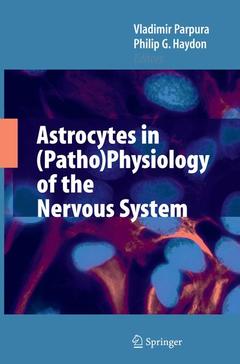Description
Astrocytes in (Patho)Physiology of the Nervous System, Softcover reprint of the original 1st ed. 2009
Coordinators: Parpura Vladimir, Haydon Philip G.
Language: English
Subjects for Astrocytes in (Patho)Physiology of the Nervous System:
Keywords
Nervous System; astrocytes; glial cell; information processing; neurons; physiology; regulation
Astrocytes in (Patho)Physiology of the Nervous System
Publication date: 05-2017
Support: Print on demand
Publication date: 05-2017
Support: Print on demand
Astrocytes in pathophysiology of the nervous system
Publication date: 12-2008
738 p. · 15.5x23.5 cm · Hardback
Publication date: 12-2008
738 p. · 15.5x23.5 cm · Hardback
Description
/li>Contents
/li>Comment
/li>
Astrocytes were the original neuroglia that Ramón y Cajal visualized in 1913 using a gold sublimate stain. This stain targeted intermediate filaments that we now know consist mainly of glial fibrillary acidic protein, a protein used today as an astrocytic marker. Cajal described the morphological diversity of these cells with some ast- cytes surrounding neurons, while the others are intimately associated with vasculature. We start the book by discussing the heterogeneity of astrocytes using contemporary tools and by calling into question the assumption by classical neuroscience that neurons and glia are derived from distinct pools of progenitor cells. Astrocytes have long been neglected as active participants in intercellular communication and information processing in the central nervous system, in part due to their lack of electrical excitability. The follow up chapters review the ?nuts and bolts? of ast- cytic physiology; astrocytes possess a diverse assortment of ion channels, neu- transmitter receptors, and transport mechanisms that enable the astrocytes to respond to many of the same signals that act on neurons. Since astrocytes can detect chemical transmitters that are released from neurons and can release their own extracellular signals there is an increasing awareness that they play physiological roles in regulating neuronal activity and synaptic transmission. In addition to these physiological roles, it is becoming increasingly recognized that astrocytes play critical roles during pathophysiological states of the nervous system; these states include gliomas, Alexander disease, and epilepsy to mention a few.
Astrocyte Heterogeneity or Homogeneity?.- Neural Stem Cells Disguised as Astrocytes.- Neurotransmitter Receptors in Astrocytes.- Specialized Neurotransmitter Transporters in Astrocytes.- Connexin Expression (Gap Junctions and Hemichannels) in Astrocytes.- Regulation of potassium by glial cells in the centralnervous system.- Energy and Amino Acid Neurotransmitter Metabolism in Astrocytes.- Calcium ion signaling in astrocytes.- Astrocytes in Control of the Biophysical Properties of Extracellular Space.- Structural association of astrocytes with neurons and vasculature: Defining territorial boundaries.- Synaptic Information Processing by Astrocytes.- Mechanisms of transmitter release from astrocytes.- Release of Trophic Factors and Immune Molecules from Astrocytes.- Molecular approaches for studying astrocytes.- The tripartite synapse.- Glia-derived D-serine and synaptic plasticity.- Purinergic signaling in astrocyte function and interactions with neurons.- Astrocyte control of blood flow.- A Role for Glial Cells of the Neuroendocrine Brain in the Central Control of Female Sexual Development.- Physiological and Pathological Roles of Astrocyte-mediated Neuronal Synchrony.- Role of Ion Channels and Amino-Acid Transporters in the Biology of Astrocytic Tumors.- Connexins and pannexins: Two gap junction families mediating glioma growth control.- The Impact of Astrocyte Mitochondrial Metabolism on Neuroprotection During Aging.- Alexander Disease: A Genetic Disorder of Astrocytes.- Role of Astrocytes in Epilepsy.- Hepatic Encephalopathy: A Primary Astrocytopathy.
Presents latest research of the role of astrocytes in the physiology and pathophysiology of brain
© 2024 LAVOISIER S.A.S.
These books may interest you

Astrocytes and Epilepsy 100.44 €



